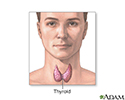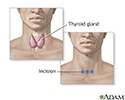Thyroid cancer
Tumor - thyroid; Cancer - thyroid; Nodule - thyroid cancer; Papillary thyroid carcinoma; Medullary thyroid carcinoma; Anaplastic thyroid carcinoma; Follicular thyroid cancer
Thyroid cancer is a cancer that starts in the thyroid gland. The thyroid gland is located inside the front of your lower neck.
Causes
Thyroid cancer can occur in people of any age.
Radiation increases the risk of developing thyroid cancer. Exposure may occur from:
-
Radiation therapy
to the neck (especially in childhood)
Radiation therapy
Radiation therapy uses high-powered x-rays, particles, or radioactive seeds to kill cancer cells.
 ImageRead Article Now Book Mark Article
ImageRead Article Now Book Mark Article - Radiation exposure from nuclear plant disasters
Other risk factors are a family history of thyroid cancer and chronic goiter (enlarged thyroid).
Goiter
A simple goiter is an enlargement of the thyroid gland. It is usually not a tumor or cancer.

There are several types of thyroid cancer:
-
Anaplastic carcinoma
(also called giant and spindle cell cancer) is the most dangerous form of thyroid cancer. It is rare, and spreads quickly.
Anaplastic carcinoma
Anaplastic thyroid carcinoma is a rare and aggressive form of cancer of the thyroid gland.
 ImageRead Article Now Book Mark Article
ImageRead Article Now Book Mark Article - Follicular tumor is more likely to come back and spread.
- Medullary carcinoma is a cancer of non-thyroid cells that are normally present in the thyroid gland. This form of thyroid cancer tends to occur in families.
-
Papillary carcinoma
is the most common type, and it usually affects women of childbearing age. It spreads slowly and is the least dangerous type of thyroid cancer.
Papillary carcinoma
Papillary carcinoma of the thyroid is the most common cancer of the thyroid gland. The thyroid gland is located inside the front of the lower neck....
 ImageRead Article Now Book Mark Article
ImageRead Article Now Book Mark Article
Symptoms
Symptoms vary depending on the type of thyroid cancer, but may include:
- Cough
- Difficulty swallowing
- Enlargement of the thyroid gland
- Hoarseness or changing voice
- Neck swelling
- Thyroid lump (nodule)
Exams and Tests
Your health care provider will perform a physical exam. This may reveal a lump in the thyroid, or swollen lymph nodes in the neck.
The following tests may be done:
-
Calcitonin
blood test to check for medullary thyroid cancer
Calcitonin
The calcitonin blood test measures the level of the hormone calcitonin in the blood.
Read Article Now Book Mark Article -
Laryngoscopy
(looking inside the throat using a mirror or flexible tube called a laryngoscope placed through the mouth)
Laryngoscopy
Laryngoscopy is an exam of the voice box (larynx). It can be done using a small mirror held just below the back of your palate, or a rigid or flexib...
 ImageRead Article Now Book Mark Article
ImageRead Article Now Book Mark Article - Thyroid biopsy
-
Thyroid scan
Thyroid scan
A thyroid scan uses a radioactive iodine tracer to examine the structure and function of the thyroid gland. This test is often done together with a ...
 ImageRead Article Now Book Mark Article
ImageRead Article Now Book Mark Article -
TSH
, free
T4
(blood tests for thyroid function)
TSH
A TSH test measures the amount of thyroid stimulating hormone (TSH) in your blood. TSH is produced by the pituitary gland. It tells the thyroid gla...
 ImageRead Article Now Book Mark Article
ImageRead Article Now Book Mark ArticleT4
T4 (thyroxine) is the main hormone produced by the thyroid gland. A laboratory test can be done to measure the amount of free T4 in your blood....
 ImageRead Article Now Book Mark Article
ImageRead Article Now Book Mark Article -
Ultrasound of the thyroid
Ultrasound of the thyroid
A thyroid ultrasound is an imaging method to see the thyroid, a gland in the neck that regulates metabolism.
 ImageRead Article Now Book Mark Article
ImageRead Article Now Book Mark Article
Treatment
Treatment depends on the type of thyroid cancer.
Surgery is most often done. The entire thyroid gland is usually removed . If the doctor suspects that the cancer has spread to lymph nodes in the neck, these will also be removed.
Removed
Thyroid gland removal is surgery to remove all or part of the thyroid gland. The thyroid gland is a butterfly-shaped gland located inside the front ...

Radiation therapy may be done with or without surgery. It may be performed by:
- Aiming external beam (x-ray) radiation at the thyroid
- Taking radioactive iodine by mouth
After treatment for thyroid cancer, you must take thyroid hormone pills for the rest of your life. The dosage is usually slightly higher than what your body needs. This helps keep the cancer from coming back. The pills also replace the thyroid hormone your body needs to function normally.
If the cancer does not respond to surgery or radiation, and has spread to other parts of the body, chemotherapy or targeted therapy may be used. These are only effective for a small number of people.
Chemotherapy
The term chemotherapy is used to describe cancer-killing drugs. Chemotherapy may be used to:Cure the cancerShrink the cancerPrevent the cancer from ...

Targeted therapy
Molecularly targeted anticancer agents; MTAs; Chemotherapy-targeted; Vascular endothelial growth factor-targeted; VEGF-targeted; VEGFR-targeted; Tyro...
Support Groups
You can ease the stress of illness by joining a cancer support group . Sharing with others who have common experiences and problems can help you not feel alone.
Cancer support group
The following organizations are good resources for information on cancer:American Cancer Society -- www. cancer. orgCancerCare -- www. cancercare. or...
Possible Complications
Complications of thyroid cancer may include:
- Injury to the voice box and hoarseness after thyroid surgery
- Low calcium level from accidental removal of the parathyroid glands during surgery
- Spread of the cancer to the lungs, bones, or other parts of the body
When to Contact a Medical Professional
Call your provider if you notice a lump in your neck.
Prevention
There is no known prevention. Awareness of risk (such as previous radiation therapy to the neck) can allow earlier diagnosis and treatment.
Sometimes, people with family histories and genetic mutations related to thyroid cancer will have their thyroid gland removed to prevent cancer.
References
Lai SY, Mandel SJ, Weber RS. Management of thyroid neoplasms. In: Flint PW, Haughey BH, Lund VJ, et al, eds. Cummings Otolaryngology: Head & Neck Surgery . 6th ed. Philadelphia, PA: Elsevier Saunders; 2015:chap 123.
National Comprehensive Cancer Network. NCCN clinical practice guidelines in oncology: thyroid carcinoma. Updated 2016. www.nccn.org/professionals/physician_gls/PDF/thyroid.pdf . Accessed March 17, 2016.
PDQ thyroid cancer treatment. National Cancer Institute Web site. Updated February 4, 2016. www.cancer.gov/cancertopics/pdq/treatment/thyroid/HealthProfessional . Accessed March 17, 2016.
Schneider DF, Mazeh H, Lubner SJ, et al. Cancer of the endocrine system. In: Niederhuber JE, Armitage JO, Doroshow JH, Kastan MB, Tepper JE, eds. Abeloff's Clinical Oncology . 5th ed. Philadelphia, PA: Elsevier Saunders; 2014:chap 71.
-
Endocrine glands - illustration
Endocrine glands release hormones (chemical messengers) into the bloodstream to be transported to various organs and tissues throughout the body. For instance, the pancreas secretes insulin, which allows the body to regulate levels of sugar in the blood. The thyroid gets instructions from the pituitary to secrete hormones which determine the pace of chemical activity in the body (the more hormone in the bloodstream, the faster the chemical activity; the less hormone, the slower the activity).
Endocrine glands
illustration
-
Thyroid cancer - CT scan - illustration
This CT scan of the upper chest (thorax) shows a malignant thyroid tumor (cancer). The dark area around the trachea (marked by the white U-shaped tip of the respiratory tube) is an area where normal tissue has been eroded and died (necrosis) as a result of tumor growth.
Thyroid cancer - CT scan
illustration
-
Thyroid cancer - CT scan - illustration
This CT scan shows a thyroid cancer tumor in the throat, encircling, narrowing, and displacing the windpipe (trachea).
Thyroid cancer - CT scan
illustration
-
Thyroid gland - illustration
The thyroid gland, a part of the endocrine (hormone) system, plays a major role in regulating the body's metabolism.
Thyroid gland
illustration
-
Incision for thyroid gland surgery - illustration
The thyroid is a gland located in the neck. It is a part of the endocrine (hormone) system, and plays a major role in regulating the body's metabolism. If surgery or an open excisional biopsy is needed, an incision is made in front of the neck to gain access to the thyroid gland.
Incision for thyroid gland surgery
illustration
-
Endocrine glands - illustration
Endocrine glands release hormones (chemical messengers) into the bloodstream to be transported to various organs and tissues throughout the body. For instance, the pancreas secretes insulin, which allows the body to regulate levels of sugar in the blood. The thyroid gets instructions from the pituitary to secrete hormones which determine the pace of chemical activity in the body (the more hormone in the bloodstream, the faster the chemical activity; the less hormone, the slower the activity).
Endocrine glands
illustration
-
Thyroid cancer - CT scan - illustration
This CT scan of the upper chest (thorax) shows a malignant thyroid tumor (cancer). The dark area around the trachea (marked by the white U-shaped tip of the respiratory tube) is an area where normal tissue has been eroded and died (necrosis) as a result of tumor growth.
Thyroid cancer - CT scan
illustration
-
Thyroid cancer - CT scan - illustration
This CT scan shows a thyroid cancer tumor in the throat, encircling, narrowing, and displacing the windpipe (trachea).
Thyroid cancer - CT scan
illustration
-
Thyroid gland - illustration
The thyroid gland, a part of the endocrine (hormone) system, plays a major role in regulating the body's metabolism.
Thyroid gland
illustration
-
Incision for thyroid gland surgery - illustration
The thyroid is a gland located in the neck. It is a part of the endocrine (hormone) system, and plays a major role in regulating the body's metabolism. If surgery or an open excisional biopsy is needed, an incision is made in front of the neck to gain access to the thyroid gland.
Incision for thyroid gland surgery
illustration
Review Date: 2/12/2016
Reviewed By: Todd Gersten, MD, Hematology/Oncology, Florida Cancer Specialists & Research Institute, Wellington, FL. Review provided by VeriMed Healthcare Network. Also reviewed by David Zieve, MD, MHA, Isla Ogilvie, PhD, and the A.D.A.M. Editorial team.





